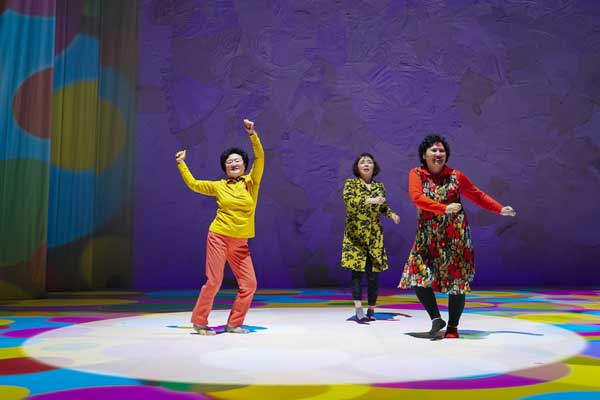As the days lengthen the weather brightens, flip-flops emerge from the dusty caverns of winter wardrobes, and festival season in Australia comes out to play.
So at which place could you see Dancing Grandmothers, an acrobatics troupe featuring Shaolin Monks, or an opera performed entirely by Artificial Intelligence? Douglas Gautier AM, CEO and Artistic Director of the Adelaide Festival Centre says it's OzAsia, where cultures collide and fuse, where artists, musicians and disruptors gather for a smorgasbord of cultural activity played out in the vibrant capital of Adelaide.
While living in Asia for 25 years, Douglas was Director of the Hong Kong Arts Festival and Deputy Executive Director of the Hong Kong Tourism Board. His secondment from the BBC Arts and Music programme was the catalyst for his extensive and immersive work in the Asia-Pacific region. “I spent a lot of time out there, in media and arts and entertainment. It’s our region. We may be at the Southern end of it, but it’s our neck of the woods,” he says. “It is an extremely exciting and diverse area. There is no question that in terms of creative economic power, the most exciting place to be is Asia-Pacific. It leads the world. Whether in music, film, computer gaming, theatre, dance, you name it, it’s happening. For Australia [OzAsia] is a great opportunity to be part of it.”
Joseph Mitchell, Artistic Director of this year’s OzAsia, says that the festival will “transform audiences’ perspectives on Asia”. Douglas’ evident passion for art from the Asia-Pacific in all its forms confirms this.

'Dancing Grandmothers' - Image © Eunji Park
“This is something we’ve been working on for 12 years, and Joseph has taken the festival to a very contemporary place. It is reflective of the complexity and the wide vista of the arts that are on offer in Asia in all their various forms. It really does showcase some of the great contemporary work, particularly in dance and multimedia and mixed form, that is happening in places like Korea and Hong Kong and China. Our audiences have come with us a long way right from the very beginning and are now very curious to see that showcase of work coming out of the Asia-Pacific. We as a nation have a very strong understanding that geographically and politically we are part of Asia, and that increasingly there is much of Asia in Australia. Because our communities are changing and so those influences from Indonesia, from China, from Korea, from India are very strong, and growing in our own communities. That diversity is another thing that this festival specifically celebrates.”
OzAsia Festival is renowned for pushing the boundaries of conventional art forms. With an incisive knowledge that spans a broad landscape of Asian contemporary art, it's interesting to hear Douglas’ opinion on particular works in this year’s festival programme where this will play out.

'Here Is The Message You Asked For'
“The Chinese work 'Here Is The Message You Asked For'. It’s a portrait of digital disconnection, but a cyber reality. It is a production where the performers react with the audience entirely through text messaging. The work that we’re doing with The Zephyr Quartet, and the work that they’re doing in conjunction with Singapore’s SAthecollective musicians, takes a different sort of direction in terms of blending and fusing creative work from two places. Last year we had an opera from Japan that was totally Artificial Intelligence, there was nobody on stage. But it was a fully blown opera.
“It’s interesting in Asia because the cultural precepts and visions are their own, but then you’ve added in maybe a hundred years or so of very strong Western influence. Now many artists in the Asia-Pacific are incorporating both of those sets of sensibilities and ideas in the work that we’re doing for the 21st century. Our visual arts are very much reflective of contemporary artists in a 21st century Asia, very different in some respects to what was seen in Europe and North America, but very much of this century.”

Zephyr Quartet
There is real excitement from Douglas regarding the collaborations between Australian and international artists that are nourished by this festival.
“'Sutra' is a great piece of work which looks at that East-West collaboration. Coming together with the Shaolin Monks in this piece it is quite extraordinary. There are interesting conjunction points between Western and Asian traditions,” Douglas says. “From a creative point of view, a contemporary point of view, that’s it in a nutshell. We are doing a lot of work with Chinese music, there’s a big collaboration between the Elder Conservatorium here and their own Chinese orchestra which is great, and other musicians that we’re bringing in from China.
“We’re doing work in the punk electro area: The Hormones are a group out of China for young female musicians, and they’re working with two Australian bands, one called Rackett out of Sydney, and the other one called The Villenettes, who are from Adelaide, working on a joint collaboration. They’ve got a show that they put together already, but we’re hoping that there will be other things to come out of this. We are going to see a number of Australian authors being involved in Jaipur Literature Festival Satellite, particularly Australian authors who are taking a broader view of Australian work and connection with Asia-Pacific. Our intention has always been to see where we can get Australian artists and Asian artists collaborating together, for work which in some cases will span more than one festival.”

Rackett - Image © Tom Wilkinson
It will be fascinating to see that played out in Adelaide, an Australian space of thriving cultural vibrancy.
“It is festival city. I think all of us here, including the government, the partners, the cultural institutions, we all work hard to make sure it is a festival capital year-round. When we launched OzAsia 12 years ago, in those days it was the only major event which was celebrating Australian/Asian cultural engagement. From my point of view, coming directly from running the Hong Kong Arts Festival, I felt pretty strongly about that. I still think nationally it is the leader in that regard. It is such an important area of engagement, OzAsia is really a broad alliance festival.
“We work with lots of other organisations, from the gallery here to the media resource centre to smaller venues. We work very strongly with the communities. We have the Moon Lantern Parade here which involves all the schools making lanterns, many of those in the Indian community and Chinese community and Korean community are performing on that day with our lamp parade. Last year we had about 50,000 people in the park. It is something that is embraced across the community by both Asian and non-Asian Australians.”
OzAsia Festival runs from 25 October-11 November.






